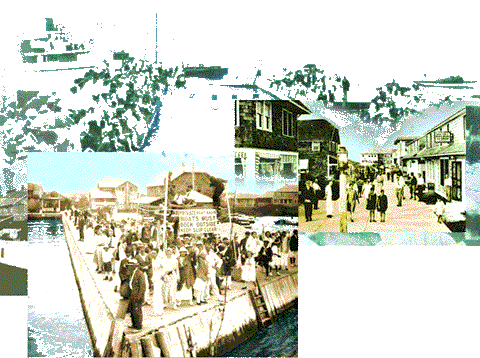ORIGIN OF NAME
The origin of Fire Island's name is not certain. It is believed its Native American name was Sictem Hackey which translated to "Land of the Secatogues". The Secatogues were a tribe in the Bay Shore, New York, area. It was part of what was also called the "Seal Islands."
Historian Richard Bayles suggested that the name Fire derives from a misinterpretation or corruption of the Dutch word "vijf" (for five) or in another version "vier" (or four) referring to the number of islands near the Fire Island inlet.
At times histories have referred to it in the plural Fire Islands because of the inlet breaks. Other versions say the island derived its name from fires built on the sea's edge by Native Americans or by pirates to lure unsuspecting ships into the sandbars.
topSome say it is how portions of the island look to be on fire from sea in the Autumn. Yet another version says it comes from the rash caused by poison ivy on the island.
The name of Fire Island first appeared on a deed in 1789.
While the western portion of the island was referred to as Fire Island for many years the eastern portion was referred to as Great South Beach until 1920 when widespread development of the island caused the whole island to be referred to as Fire Island.

![]()
TIMELINE / SETTLEMENT

![]()
HISTORY
Fire Island, its shores and elevations constantly shifting, represents a kind of equilibrium among mighty natural forces. In 1653, Isaac Stratford of Babylon set up a shore whaling station on the Island (the name, Whalehouse Point, still persists). Stratford's crews would carry their whaleboats across the Island to the ocean side, build crude shelters and erect a look-out from which a man could watch for the spouting of a whale. "Whale Off!" he would cry when the great beast was sighted, and the boats would be launched into the rough surf.
In 1825 the Federal government constructed a lighthouse at the extreme western tip of Fire Island. As late as 1856, a boatman sailing through the Inlet could toss a newspaper to the lighthousekeeper. Less than 100 years later, four miles of sand had accumulated between the lighthouse and the western end of the Island.
During the early 1920's, the Island found fame as a Bohemian retreat. The rum flowed in and the whine of high-speed Coast Guard cutters slashed the early morning air. The beaches were littered with copies of Variety and Billboard, the saloons cluttered with penciled manuscripts and blue air, and back porches were congested by the acrid smell of oils.
topBut behind all this frivolity, business continued in the form of rampant real estate speculation.
In the three centuries since Isaac Stratford established his whaling station, the Island has undergone many changes . . . it has developed into a vacation-land whose few year-round inhabitants derive their living from providing goods and services to the summer visitors.
It's impossible to speak of Fire Island as a unity for there are as many different Fire Islands as there are types of people in New York. Fire Island is many things to many people and each year thousands visit Fire Island to frolic on the playground of the suntan set to see if all the things they've heard are really true. And they are.
Fire Island has a beauty all of its own -- a lonely loveliness other resorts don't possess. It's the isolation of the place, the utter aloneness. At no time do you feel less like leaving the Island than in the warm late Sunday afternoon when it's time to begin walking toward the bay, toward the ferry waiting to return you to the mainland. You will discover, as everyone who truly likes the island does, that special, secret magic of the place.
